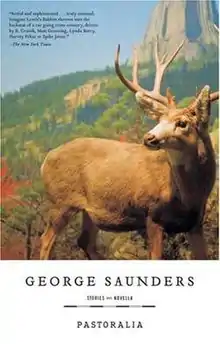Pastoralia
Pastoralia is short story writer George Saunders’s second full-length short story collection, published in 2000. The collection received highly positive reviews from book critics and was ranked the fifth-greatest book of the 2000s by literary magazine The Millions.[1] The book consists of stories that appeared (sometimes in different forms) in The New Yorker; most of the stories were O. Henry Award Prize Stories. The collection was a New York Times Notable Book for 2001.
 US release cover | |
| Author | George Saunders |
|---|---|
| Cover artist | Rodrigo Corral |
| Country | United States |
| Language | English |
| Publisher | Riverhead Books |
Publication date | June 2000 |
| Media type | Print (hardcover) |
| Pages | 208 p. |
| ISBN | 1-57322-872-9 |
Reception
Pastoralia received general acclaim from book critics. Chris Lehmann of Salon praised its relevance, calling Saunders a "master of distilling the disorders of our time into fiction."[2] Lynne Tillman of The New York Times argued the stories "cover larger, more exciting territory" than Saunders' previous works, "with an abundance of ideas, meanings and psychological nuance."[3] Pastoralia is also well-known for its writing style, which has been described as deadpan, realist, and/or postmodern.[4][5] Iranian-American novelist and essayist Porochista Khakpour cited the "seamless coexistence of high and low" in the book's prose.[6] A writer for Nylon argued the book's deadpan delivery and "satiric vision of contemporary America [secures Saunders'] place" as a successor to 20th century literary realists such as Thomas Pynchon and Kurt Vonnegut.[7]
In 2007, Entertainment Weekly ranked the book #63 on its list of the top 100 works of literature since 1983.[8] The following year, Emily VanDerWerff of The A.V. Club ranked it one of the ten best short story collections of the 2000s.[9]
Contents
| Story | Originally published in | Date |
|---|---|---|
| "Pastoralia" | shorter form in The New Yorker | April 3, 2000 |
| "Winky" | The New Yorker | July 28, 1997 |
| "Sea Oak" | The New Yorker | December 28, 1998 |
| "The End of FIRPO in the World" | The New Yorker | May 18, 1998 |
| "The Barber's Unhappiness" | The New Yorker | December 20, 1999 |
| "The Falls" | The New Yorker | January 22, 1996 |
Awards, honors and other appearances
- "Pastoralia" was an O. Henry Award Prize Story in 2001.
- "Winky" Was an O. Henry Award Prize Story in 1998.
- "Sea Oak" was an O. Henry Award Prize Story in 1999. It was nominated for the 1999 Bram Stoker Award. It was also reprinted in Feeling Very Strange: The Slipstream Anthology, edited by James Patrick Kelly and John Kessel; it was also reprinted in American Fantastic Tales: Terror and the Uncanny from the 1940s to Now, edited by Peter Straub.
- "The Falls" was an O. Henry Award Prize Story in 1997.
Influence
- The eponymous story inspired the GEICO Cavemen ad campaign.[10]
References
- Best of the Millennium, Pros vs. Readers
- "It's a theme-park life". Salon. 2000-04-26. Retrieved 2019-09-11.
- Tillman, Lynne. "Future Shock: a story collection discovers the future in the present". The New York Times. Retrieved 4 November 2014.
- Rando, David P. (2012). "George Saunders and the Postmodern Working Class". Contemporary Literature. 53 (3): 437–460. doi:10.1353/cli.2012.0024. S2CID 163027910.
- "Pastoralia — George Saunders". 22 November 2011.
- Khakpour, Porochista (24 September 2009). "Best of the Millennium #5: Pastoralia by George Saunders". The Millions. Retrieved 4 November 2014.
- "THE BRIEF AND FRIGHTENING REIGN OF PHIL by GEORGE SAUNDERS". www.reignofphil.com. Archived from the original on 2007-03-14.
- "The New Classics: Books". Entertainment Weekly. 18 June 2007. Retrieved 4 November 2014.
- VanDerWerff, Emily (25 November 2009). "The 10 best short-story collections of the '00s". The A.V. Club. Retrieved 4 November 2014.
- What gave you that idea